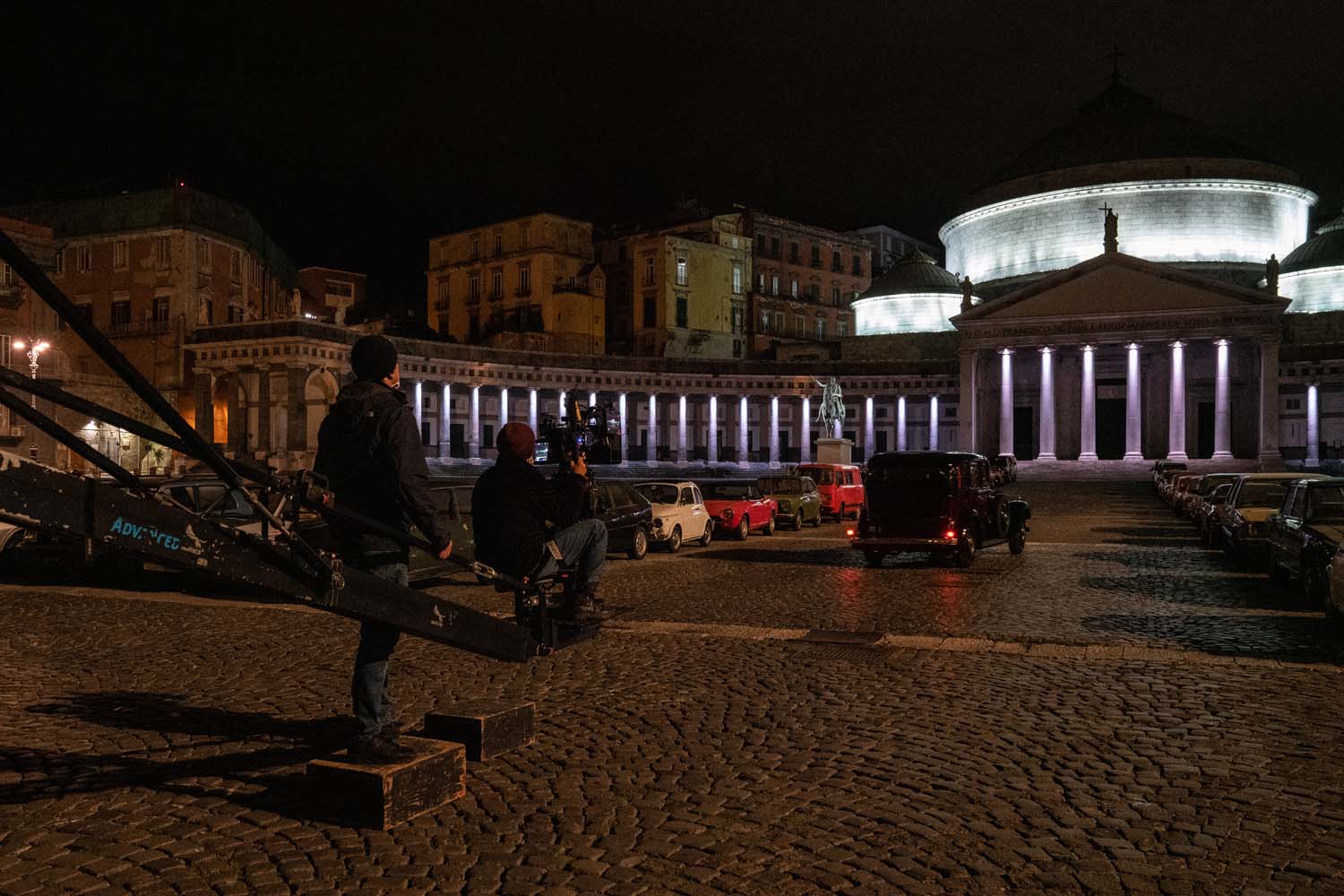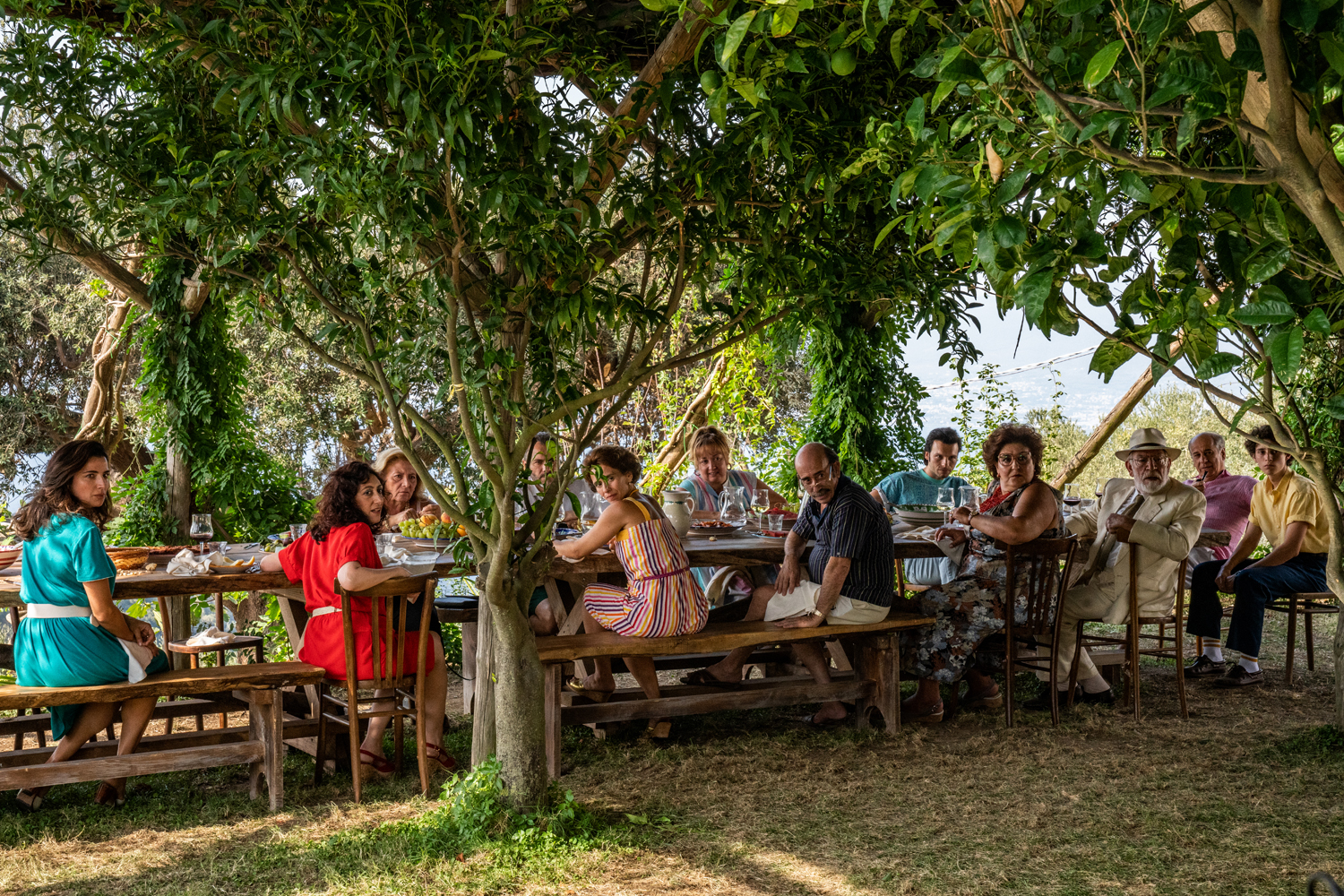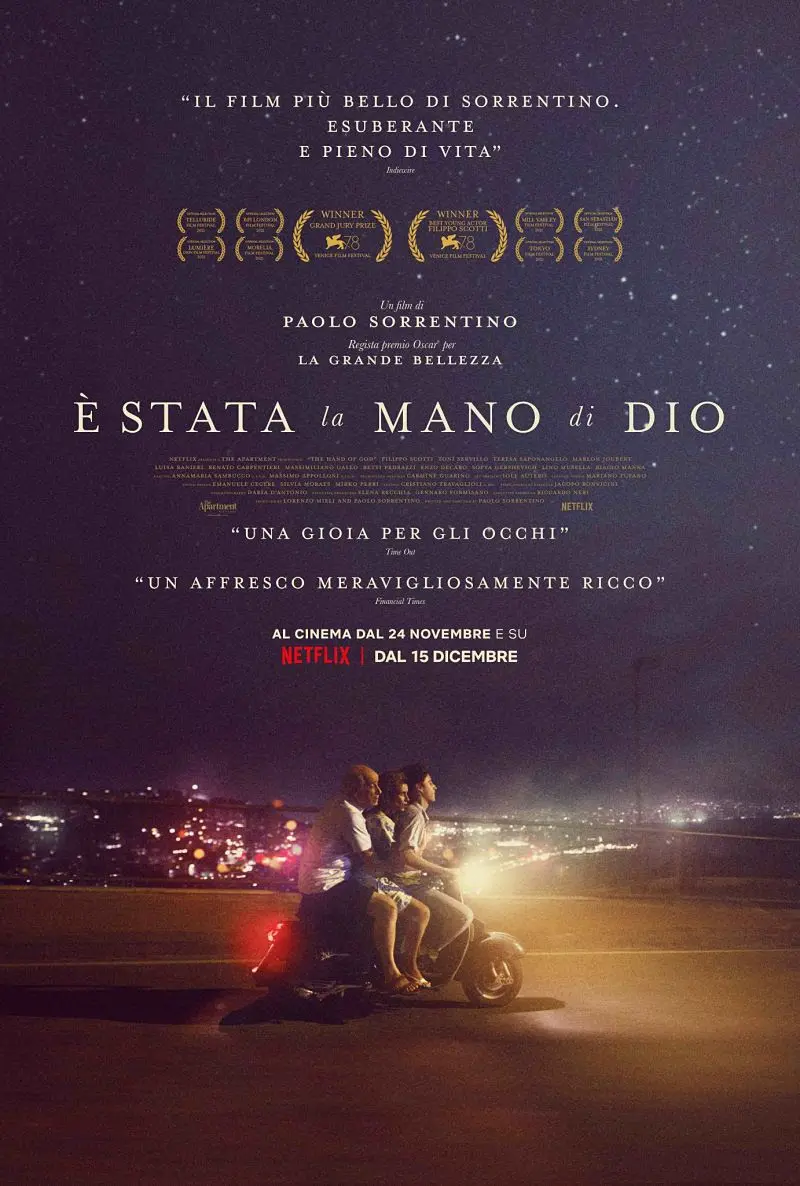

“I don’t’like reality anymore. Reality is lousy. That’s why I want to make films”
Fabietto Schisa
Exactly 20 years after his directorial debut One Man Up, Paolo Sorrentino has returned to the city of his birth to set a personal story, a tale of fate and family, sport and cinema, love and loss, inspired by his own experience. Set in a tumultuous Naples in the 1980s, Fabietto Schisa (Filippo Scotti) has various experiences that will change his life: soccer legend Maradona comes to the city where he is acclaimed like a god and a tragic accident involves his family.
It is a quote from the city’s idol that opens the film: I did what I could, I don’t think I did too badly, as a water-skimming sequence across the Gulf of Naples by day presents the city as, indisputably, a main character, framing her almost as if she is considering her reflection in the Bay: Castel dell’Ovo on the right slowly fades to reveal the shorelines of Chiaia and via Caracciolo, where a vintage car is travelling.

It’s night in the following scene. In piazza del Plebiscito (full of parked cars as it was in the 1980s), Patrizia (Luisa Ranieri) accepts a lift from “St. Gennaro”. Some minutes later he takes her to the courtyard of Palazzo Zapata, several metres distant in adjacent piazza Trieste e Trento, to show her o munaciello, a child monk from the Neapolitan folk tradition who promises to solve all her problems. However, the room where Patrizia is taken is in the 17th century Villa del Cardinale in Torre del Greco: an enormous crystal chandelier lying in ruins on the floor at the centre of this space decorated with precious marble and stuccowork, damaged in the earthquake of 1980, gives the scene a special atmosphere.
Fabietto’s world is his happy family, whose love for life overcomes any problem: their harmony is on full display in a night scene on the coastal via Francesco Petrarca, as father, mother and son head to Aunt Patrizia’s house, smiling and tightly huddled together on a single motor-scooter, driving into the wind with the sea in the background. His father Saverio (Toni Servillo) works for the Bank of Naples and one scene shows its headquarters in via Toledo. The set for the Schisa family home is an apartment in via San Domenico in the Vomero neighbourhood, in the same building where the director once lived on the floor below.
Soccer in Naples is Maradona, an event that paralyses the city and brings family and friends together even when the teams playing are neither their home team nor Italy. Vomero is the location for the apartment where the family gathers to watch the Argentina-England 1986 Fifa World Cup quarterfinal match when the ‘hand of God’ goal that gives the film its title took place. Computer graphics recreates the former stadium of San Paolo (later renamed for the city’s unforgotten soccer idol who died in 2020) as it was in the 1980s, making it one of the most significant locations in the film along with the Collana stadium.
Galleria Umberto I is a recurring location: for his father Saverio’s childhood recollection, for solitary walks and for a film shoot which fascinates Fabietto so much that it points the way to his future. That path becomes even clearer to him on the night he meets the director, Antonio Capuano, with whom he has an illuminating conversation at Villa d’Abro in Posillipo, a Neo-Romanesque residence built by architect Alfonso Guerra in 1870.

Naples is the centre of Fabietto’s life but some scenes take him out of the city. The villa in Acerola where the family attends the arrival of Saverio’s sister with her new boyfriend is Villa Giusso Astapiana actually in Vico Equense overlooking the Sorrento peninsula at an altitude of 400m. Frames that follow show the Protected Marine Area of Punta Campanella, where the family takes a boat trip near Massa Lubrense and stops to swim off Isolotto Isca, once the property of Eduardo De Filippo who is quoted by Saverio Schisa as he makes a grand declaration of love for his wife Maria (Teresa Saponangelo); a short while later, while everyone on board is admiring Aunt Patrizia’s nudity, Fabietto watches police chase a motorboat of smugglers. The entire family disembarks in the harbour of Cetarawhere Fabietto spots Armando, one of the smugglers, later to become his friend.
Capri, her famous piazzetta uncannily empty, is the destination for a crazy night for Fabio and Armando, which begins in Naples Harbour with a provoked fight, continues with their escape on a motor-scooter and a sea-crossing in a motorboat where the city once again shines in the water. The night ends on the Amalfi Coast in Conca dei Mariniwhere Fabio and Armando seal their friendship with a swim in the evocative Emerald Grotto. Lastly, the island of Stromboli in the Aeolian archipelago, with its smoking volcano and dark sand, welcomes Fabietto and his brother Marchino for their holidays.
The scenes in Roccaraso, (province of L’Aquila) where Fabietto’s parents buy a house, were actually shot in the mountain town and in nearby Castel di Sangro.
“I don’t’like reality anymore. Reality is lousy. That’s why I want to make films”
Fabietto Schisa
Exactly 20 years after his directorial debut One Man Up, Paolo Sorrentino has returned to the city of his birth to set a personal story, a tale of fate and family, sport and cinema, love and loss, inspired by his own experience. Set in a tumultuous Naples in the 1980s, Fabietto Schisa (Filippo Scotti) has various experiences that will change his life: soccer legend Maradona comes to the city where he is acclaimed like a god and a tragic accident involves his family.
It is a quote from the city’s idol that opens the film: I did what I could, I don’t think I did too badly, as a water-skimming sequence across the Gulf of Naples by day presents the city as, indisputably, a main character, framing her almost as if she is considering her reflection in the Bay: Castel dell’Ovo on the right slowly fades to reveal the shorelines of Chiaia and via Caracciolo, where a vintage car is travelling.

It’s night in the following scene. In piazza del Plebiscito (full of parked cars as it was in the 1980s), Patrizia (Luisa Ranieri) accepts a lift from “St. Gennaro”. Some minutes later he takes her to the courtyard of Palazzo Zapata, several metres distant in adjacent piazza Trieste e Trento, to show her o munaciello, a child monk from the Neapolitan folk tradition who promises to solve all her problems. However, the room where Patrizia is taken is in the 17th century Villa del Cardinale in Torre del Greco: an enormous crystal chandelier lying in ruins on the floor at the centre of this space decorated with precious marble and stuccowork, damaged in the earthquake of 1980, gives the scene a special atmosphere.
Fabietto’s world is his happy family, whose love for life overcomes any problem: their harmony is on full display in a night scene on the coastal via Francesco Petrarca, as father, mother and son head to Aunt Patrizia’s house, smiling and tightly huddled together on a single motor-scooter, driving into the wind with the sea in the background. His father Saverio (Toni Servillo) works for the Bank of Naples and one scene shows its headquarters in via Toledo. The set for the Schisa family home is an apartment in via San Domenico in the Vomero neighbourhood, in the same building where the director once lived on the floor below.
Soccer in Naples is Maradona, an event that paralyses the city and brings family and friends together even when the teams playing are neither their home team nor Italy. Vomero is the location for the apartment where the family gathers to watch the Argentina-England 1986 Fifa World Cup quarterfinal match when the ‘hand of God’ goal that gives the film its title took place. Computer graphics recreates the former stadium of San Paolo (later renamed for the city’s unforgotten soccer idol who died in 2020) as it was in the 1980s, making it one of the most significant locations in the film along with the Collana stadium.
Galleria Umberto I is a recurring location: for his father Saverio’s childhood recollection, for solitary walks and for a film shoot which fascinates Fabietto so much that it points the way to his future. That path becomes even clearer to him on the night he meets the director, Antonio Capuano, with whom he has an illuminating conversation at Villa d’Abro in Posillipo, a Neo-Romanesque residence built by architect Alfonso Guerra in 1870.

Naples is the centre of Fabietto’s life but some scenes take him out of the city. The villa in Acerola where the family attends the arrival of Saverio’s sister with her new boyfriend is Villa Giusso Astapiana actually in Vico Equense overlooking the Sorrento peninsula at an altitude of 400m. Frames that follow show the Protected Marine Area of Punta Campanella, where the family takes a boat trip near Massa Lubrense and stops to swim off Isolotto Isca, once the property of Eduardo De Filippo who is quoted by Saverio Schisa as he makes a grand declaration of love for his wife Maria (Teresa Saponangelo); a short while later, while everyone on board is admiring Aunt Patrizia’s nudity, Fabietto watches police chase a motorboat of smugglers. The entire family disembarks in the harbour of Cetarawhere Fabietto spots Armando, one of the smugglers, later to become his friend.
Capri, her famous piazzetta uncannily empty, is the destination for a crazy night for Fabio and Armando, which begins in Naples Harbour with a provoked fight, continues with their escape on a motor-scooter and a sea-crossing in a motorboat where the city once again shines in the water. The night ends on the Amalfi Coast in Conca dei Mariniwhere Fabio and Armando seal their friendship with a swim in the evocative Emerald Grotto. Lastly, the island of Stromboli in the Aeolian archipelago, with its smoking volcano and dark sand, welcomes Fabietto and his brother Marchino for their holidays.
The scenes in Roccaraso, (province of L’Aquila) where Fabietto’s parents buy a house, were actually shot in the mountain town and in nearby Castel di Sangro.

Set in a tumultuous Naples in the 1980s, 17-year-old Fabietto Schisa has various experiences that will change his life, as he struggles to find his place in the world: the soccer legend Maradona comes to the city where he is acclaimed like a god and his family has a tragic accident.